A few weeks ago, I was preparing some chicken thighs to go on the grill. Instinctively, I reached for a jar of Paul Prudhomme’s Poultry Magic to season the chicken with. It’s a spice blend you can buy at almost any grocery store here in the U.S. There’s paprika, garlic, and onion in it, along with other mystery ingredients (the jar simply lists “spices” on the back). In addition to the “Poultry Magic” blend, there’s also Blackened Steak Magic, Seafood Magic, and even Vegetable Magic (you get the idea). For as long as I can remember, there were always jars of Paul Prudhomme spice blends in my family’s kitchen. And I suppose we often adopt products and ingredients from our childhoods into our own homes – perhaps without giving it too much thought. But that evening as I prepped the chicken, for the first time in my life, I looked down at the smiling chef on the label staring up at me, and I thought, “Who the hell is Paul Prudhomme?”
Naturally, I did some research. And it turns out, he’s kind of a legend. I would be more embarrassed by my ignorance, but I think the fact that my family has been diligently supporting this spice blend for decades makes it ok. When I polled friends and asked if they had also grown up with Prudhomme’s Magic Seasoning Blends, I got mixed responses. Some had never heard of them. Some recalled seeing a jar in the pantry. One friend told me that her mother used to put the grill seasoning on her and her sibling’s jellyfish stings when they were kids (I don’t really know what to make of that).
Paul Prudhomme was born on a farm outside of Opelousas, Louisiana in 1940. The youngest of thirteen children, he went by Gene Autry Prudhomme for most of his youth. His family were descendents of Acadians, an ethnic group descended from French settlers in Canada in the 17th and 18th century – some of whom ended up in Louisiana (if you’ve got some time, I do recommend this epic poem by Henry Wadsworth Longfellow about The Expulsion of The Acadians).
When Paul was just 17 years old, he opened his first restaurant in Opelousas: a burger joint named Big Daddy O’s Patio (I have a feeling these burgers were good). Both his restaurant and his marriage were over nine months later. What followed were some wandering years: he sold magazines out West, he cooked in various kitchens. In 1970 he moved back to New Orleans, where he would experience his meteoric rise to become one of the most famous chefs in the country.
Paul became the executive chef of Commander’s Palace in 1975. Which was a big deal for a few reasons. Commander’s Palace was (and is) an iconic New Orleans restaurant, and had been serving up Creole classics since 1893. But it was also a big deal because Paul was the first ever American-born chef to be at the helm of Commander’s, which had traditionally hired French and European chefs, to serve old school dishes like Turtle Soup au Sherry, Shrimp Remoulade, and Trout Amandine.
But with Paul in the kitchen, the menu transformed. Gene Bourg, a food writer and former Times Picayune restaurant critic, said of Prudhomme’s menu revamp,
"I remember going to Commander's and seeing these bizarre menu descriptions. This is when Paul began using all of these little puns and word plays in his menu items. He started using words like 'debris,' 'Cajun popcorn.' Nobody knew who he was, because in those days, chefs were very anonymous." (The Times Picayune)
Imagine a world before shrimp popcorn. I can think of quite a few fast casual American restaurant chains with a selection of appetizers, liberally using descriptors like “popcorn” to describe what is essentially fried protein drenched in sauce. These institutions have Paul Prudhomme to thank for this gastronomic lexicon.
What Paul brought to Commander’s was the Cajun cooking he had grown up with. When he described the roux gumbo he made at Commander’s years later to Brett Anderson as part of an oral history project, he said, “It was down-and-dirty Cajun. It was what Mama used to do. I'd go into the country and buy the andouille from the guy I'd known since I was a kid.” It wasn’t obnoxious or pretentious haute cuisine, it was simple country cooking.
Simple, but not boring. The ingredients were fresh and good quality, and their preparation was well executed. Alice Waters took note and became a fan of the restaurant. Prudhomme remembered, “We sort of fell in love over food. She had such a passion for it. I had never heard anybody be fanatical like I was. 'You raise your own chickens?' I was like, 'Somebody else is doing that?'”
By the late seventies, Paul was itching to have his own restaurant. And in 1979 he and his second wife Kay opened K-Paul’s Louisiana Kitchen, which became a New Orleans institution in its own right (Emeril Lagasse took over his position at Commander’s). The restaurant served Cajun food, which was certainly not unknown outside of Louisiana, but K-Paul’s played a part in educating the nation at large about this regional cuisine. In 1981, Paul told Craig Claiborne of The New York Times that, “Cajun cooking is old French cooking that was transformed into a Southern style when my ancestors migrated to Louisiana.” (Whereas, Creole cuisine is a mix of West African, Spanish, French and indigenous cooking styles and ingredients).
K-Pauls, which sadly shuttered in 2020, sounds like the kind of no frills restaurant that is immediately nostalgic in its modesty and integrity. In its early years, there were no freezers (when everything’s fresh, who needs freezers?) Seating was communal. It was cash only. The wine list consisted of two options: red or white. If you finished your plate, Kay would put a star sticker on your face. There were no reservations and dinner would run about $5 a person.
Over the years, as the gospel of Paul Prudhomme’s Cajun magic spread, the lines outside the restaurant grew. Throngs of hungry customers became the impetus for bestselling cookbooks. Cameras started to show up. TV appearances and cooking shows were made. There was a blockbuster New York City pop-up in 1989. One of his signature dishes, Blackened Redfish, became a nationwide craze. Indeed, there was such demand for blackened redfish that the fish almost went extinct in the Gulf of Mexico. Commercial fishing restrictions were put in place and Paul’s restaurant limited customers to one order of Blackened Redfish per table.
K-Paul’s was badly damaged during Hurricane Katrina in 2005 and spent almost a year undergoing repairs. During that time, Chef Paul cooked meals for free for relief workers and residents staying at shelters in the French Quarter. When the restaurant reopened it continued its busy daily service, feeding tourists and locals alike.
Paul Prudhomme passed away in 2015 at the age of 75, leaving behind a restaurant legacy, eleven cookbooks, and a line of Magic Seasoning Blends. In July of 2020, K-Paul’s (which had been run by Paul’s family after his passing) shuttered amidst Covid restrictions. Another Pandemic loss.
All these years, Paul Prudhomme had been an enigma to me. I didn’t think about who he was, or why he had a spice line, or if he was even a real person. He was simply the face on a jar of spice mix. All those countless meals where something was dusted in Blackened Steak Magic, or Seafood Magic or whatever it was – I had no idea that a Cajun culinary icon was behind the magic happening on the grill. A man, who in all likelihood, was probably the reason why a New York City immigrant family like mine even knew about Cajun food in the first place.
Edible History is a reader supported newsletter. To support my work and to gain access to the full archive of posts (each month paid subscribers receive additional edible histories and recipes in their inbox) consider upgrading to become a paid subscriber.
Like what you’re reading? Get a copy of my book, A History of The World in Ten Dinners (Rizzoli) available here and here.





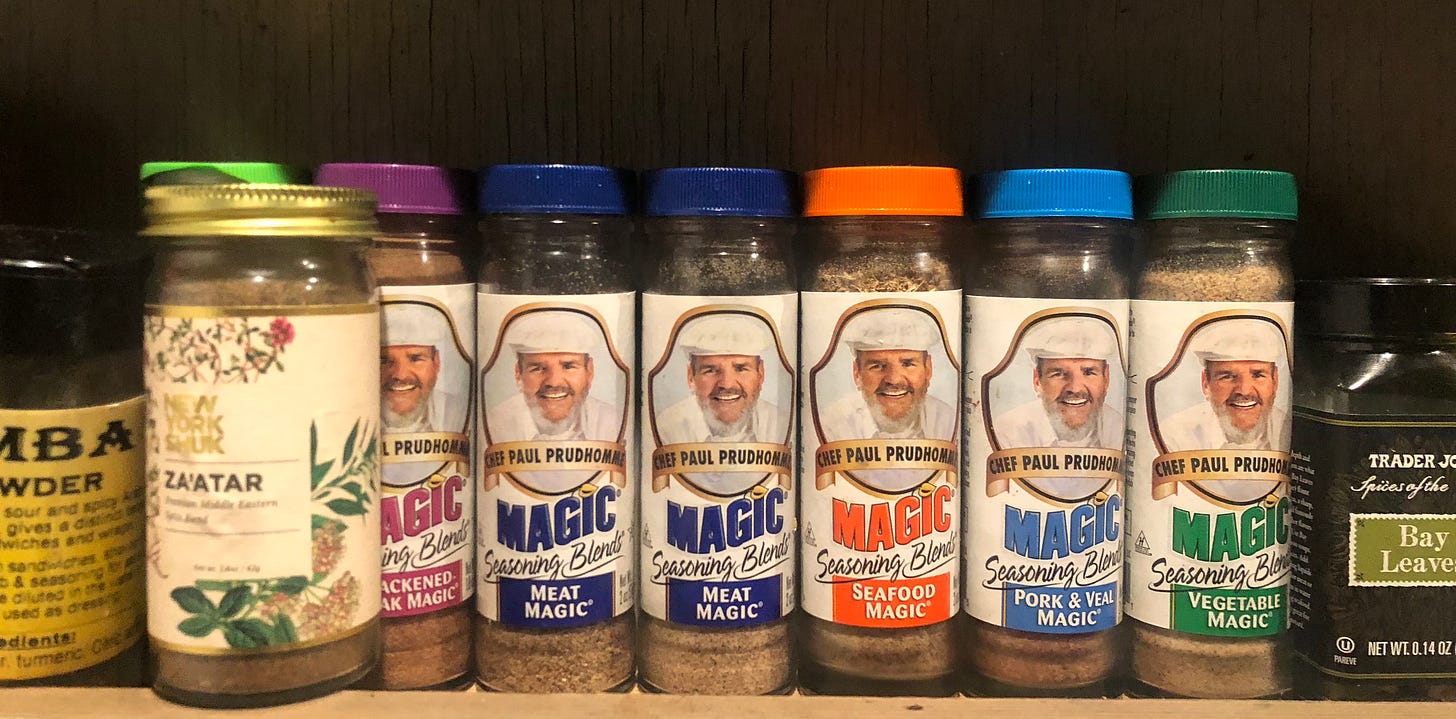
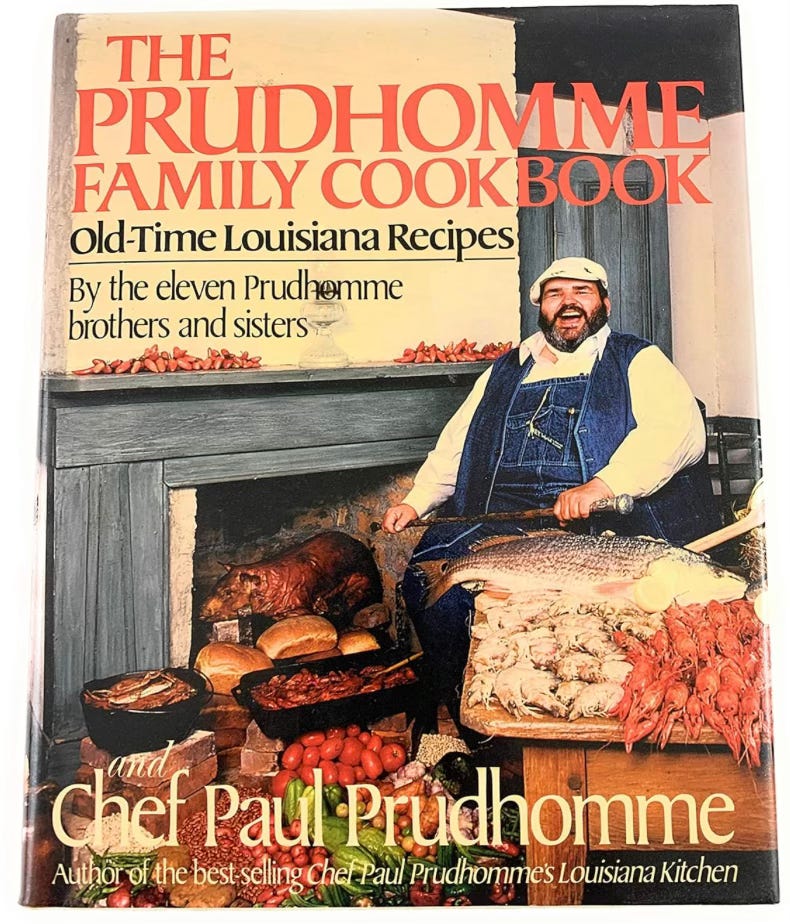
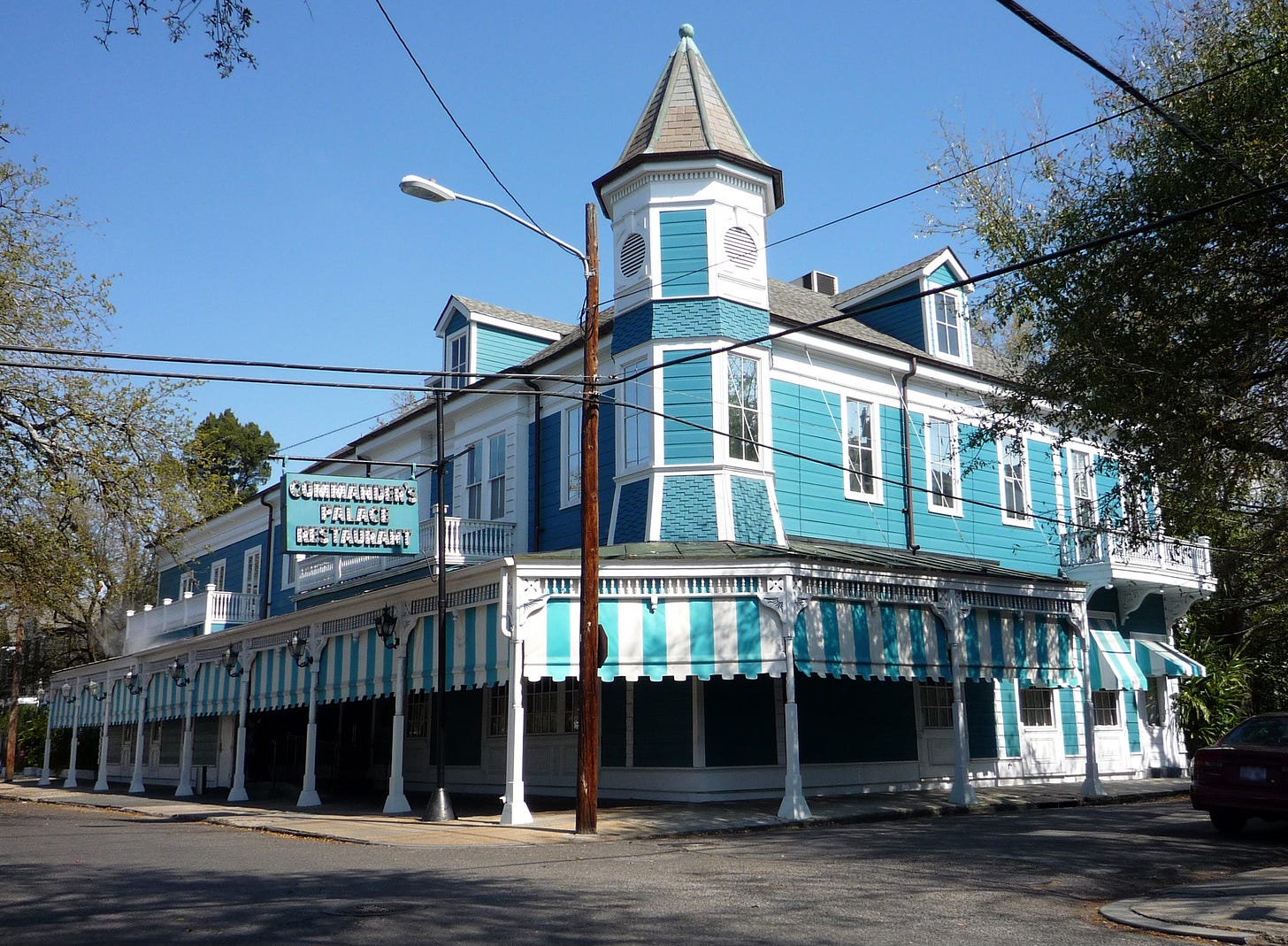
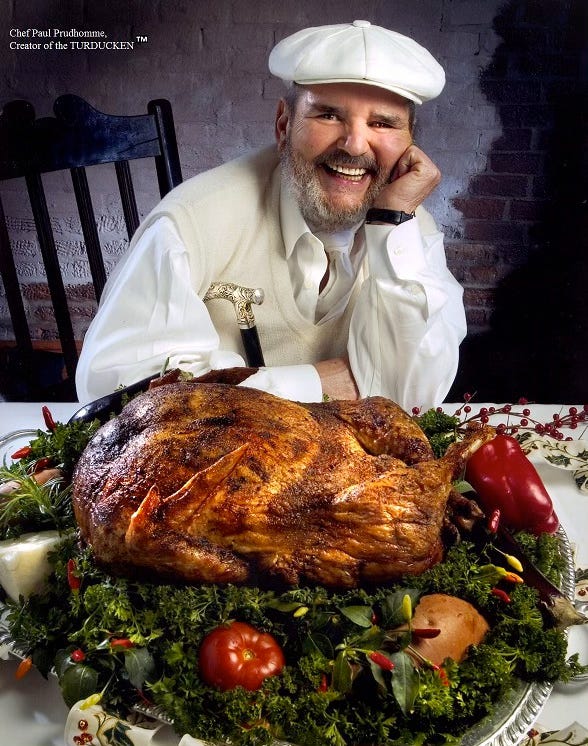
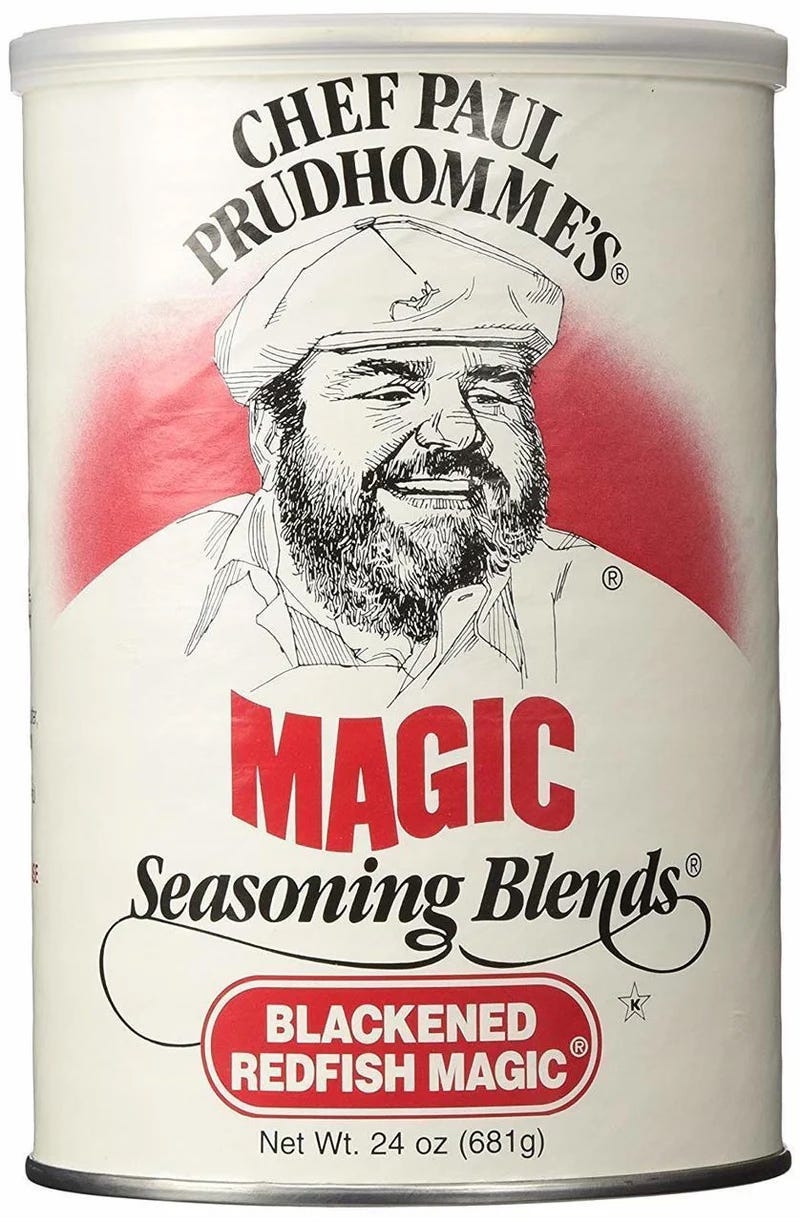
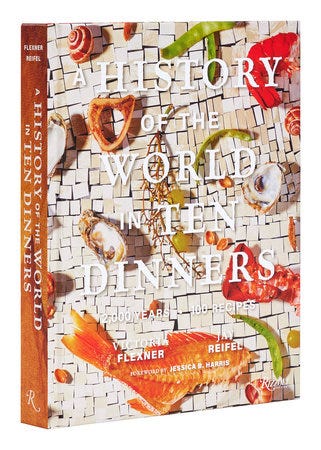
My mother's family is from the Opelousas area, so I tend to feel some type of nostalgia for its food and culture, even though I personally didn't grow up there (is nostalgia by proxy a thing?) — anyway, you might be interested to know that another big name in Cajun/Creole cooking + seasoning blends is also from Opelousas: Tony Chachere :)